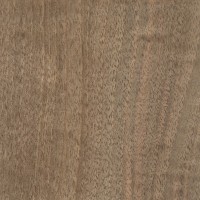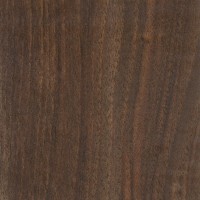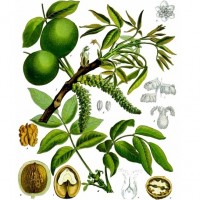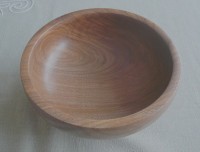 |
Common Name(s): English Walnut, Circassian Walnut, Scientific Name: Juglans regia Distribution: Eastern Europe and western Asia Tree Size: 80-115 ft (24-35 m) tall, 5-6 ft (1.5-2.0 m) trunk diameter Average Dried Weight: 40 lbs/ft3 (640 kg/m3) Specific Gravity (Basic, 12% MC): .52, .64 Janka Hardness: 1,220 lbf (5,410 N) Modulus of Rupture: 16,160 lbf/in2 (111.5 MPa) Elastic Modulus: 1,568,000 lbf/in2 (10.81 GPa) Crushing Strength: 7,280 lbf/in2 (50.2 MPa) Shrinkage: Radial: 5.5%, Tangential: 7.5%, Volumetric: 13.0%, T/R Ratio: 1.4 |
Color/Appearance: Heartwood can range from a lighter pale brown to a dark chocolate brown with darker brown streaks. Color can sometimes have a gray, purple, or reddish cast. Sapwood is nearly white. European Walnut can occasionally also be found with figured grain patterns such as: curly, crotch, and burl.
Grain/Texture: Grain is usually straight, but can be irregular. Has a medium texture and moderate natural luster.
Endgrain: Semi-ring-porous to diffuse porous; large earlywood pores grading to medium latewood pores, few; solitary and radial multiples of 2-3; tyloses occasionally to abundantly present; growth rings distinct; medium rays barely visible without lens, normal spacing; parenchyma diffuse-in-aggregates (sometimes very faint and barely visible even with lens) and banded (marginal).
Rot Resistance: English Walnut is rated as moderately durable in terms of decay resistance, though it is susceptible to insect attack.
Workability: Typically easy to work provided the grain is straight and regular. Planer tearout can sometimes be a problem when surfacing pieces with irregular or figured grain. Glues, stains, and finishes well, (though walnut is rarely stained).
Odor: English Walnut has a faint, mild odor when being worked.
Allergies/Toxicity: Although severe reactions are quite uncommon, European Walnut has been reported as a sensitizer. Usually most common reactions simply include eye and skin irritation. See the articles Wood Allergies and Toxicity and Wood Dust Safety for more information.
Pricing/Availability: English Walnut is likely to be rather expensive, and is sometimes only seen in veneer form.
Sustainability: This wood species is not listed in the CITES Appendices, but is reported by the IUCN as being near threatened. Technically it doesn’t meet the Red List criteria of a vulnerable or endangered species, but is close to qualifying and/or may qualify in the near future. This listing is for the wild populations of the tree: it should be noted that nearly all of the available lumber comes from cultivated trees.
Common Uses: Furniture, cabinetry, gunstocks, interior paneling, veneer, turned items, and other small wooden objects and novelties.
Comments: Known in Europe simply as “Walnut,” or “Common Walnut,” English Walnut (Juglans regia) is the source of what are the most common form of edible walnuts for human consumption. Branches of English Walnut are sometimes grafted onto the trunk of Claro Walnut trees in Californian walnut orchards to take advantage of the latter tree’s roots, which are better suited to the locale and produce more fruit.
Scans/Pictures: A special thanks to Steve Earis for providing the turned photo of this wood species.
 |
 |
 |
 |


English walnut endgrain.
Hello:
why haven’t I discovered this site before – fantastic!
I have been asked to make a replacement wooden plate for someone and they have sent a couple of pictures (attached). He says he has been eating meals off it for years – and has never put it in the dishwasher.
Could anyone help me with the identification? Think it may be plane. oak, elm or acacia.
I turn wood for a hobby – not as a business.
Thanks, Dave Brown
Can’t tell 100% certainty from the pictures, but it is definitely a lacewood-type of wood, quartersawn, with the ray flecks and patterns on full display. Are you in Europe, America, or somewhere else? I’m guessing Europe since you’re posting this in English walnut page, so I’d say most likely candidate would be London plane, quartersawn. It’s nearly the same as what we would call sycamore here in the US.
Hi, Just to add to my request below.
I have now cut and sanded a piece of the wood and it appears to be of diffuse porosity, generally but not exclusively in a Diagonal pattern. I would estimate the pore frequency to be at the lower end of Moderately Numerous, and there are many tyloses. It has multiple lines of rays, similar to the image of Jatoba in the Hardwood Anatomy section, spaced Fairly Close.
It is a heavy wood, but does float in water.
Thank you.
Hi Eric, I hope you might be able to help me please. I’ve been given the piece of wood in the attached photos and I think it might be Walnut. I would very much appreciate your opinion. Thanks
Hi Eric! I’m hoping you might be able to help me again ha. Do you think the lumber in the pictures below might be a walnut or mahogany? Just some background all the lumber… It was salvaged from a 55 room mansion that had a beautiful entry staircase. Unfortunately some of the floors collapsed on top of each other and ruined the existing staircase. It was built in 1906. Thank you again
It’s a bit tough to tell since the endgrain surface is still so rough, but in this instance I’d lean more toward walnut. One thing to keep in mind is that with genuine mahogany, the pores will almost always be perfectly uniform in size and evenly distributed throughout the endgrain. With walnut, it’s more varied, and will have a range of pore sizes, as well as pores that may not be equally distributed throughout the endgrain, and may be aligned in loose lines along annual growth ring boundaries.
Hi just wondering if you might be able to help me? Found this in my dad‘s garage. Just wondering if this is an English walnut? It’s an old fireplace mantle
Not walnut, it appears to have a ribbon stripe pattern, and may be a type of mahogany (more or less). https://www.wood-database.com/wood-articles/mahogany-mixups-the-lowdown/
Thank you for your response Eric! I am just seeing this. I’m not disagreeing with you but it does look more like an English walnut versus a mahogany to me. It’s also is in veneer form and sealed. I showed the two pictures from the website and my picture is at the bottom and twice the size. Thank you so much for your help again
Well without endgrain verification, there’s no way to be sure. But the color bands in your piece do not actually resemble walnut to me, it looks like ribbon stripe. Ribbon stripe pattern is due to interlocked grain, which is something that’s a much more strong indicator of mahogany.
Thank you and I appreciate all your help. Makes sense to me and you definitely know more than I do. Such a great site! Is there a way I can make a donation or anything? Thank you
If you scroll down to the bottom footer of the website, there’s a section called “Supporting the Site” that lists different ways to contribute.
I have walnut root wads from a California orchard grubbed out back in the 70’s. Trying to identify what variety it is.
Extremely dark and and similar hardness to Claro, maybe softer due to being a rootstock.
The endgrain doesn’t seem to match anything
Root wood can be very abnormal and hard to use as a basis for ID.
Thanks for your reply, the piece in the picture was from the stem right below the graft. This picture is from above the graft and seems to have characteristics of Claro (color streaks) but it doesn’t have the the light colored marginal rings like in the 1st picture.
Besides the tropical species like Juglans neotropica — which are diffuse porous — I don’t know of a way to reliably separate the temperate walnut species based on anatomy.
If it is a grafted tree and it’s from a California Walnut orchard, the section below the graft line is Claro Walnut and the section above the graft line is English Walnut.
I recently found a pallet that once I ran my belt sander on the boards, the boards turned light purple, I saved all I could and used them on a rustic table top with 3 coats of poly. It turned out really nice.
As far i know wallnut is native to the UK and then was planted world wide. You can look this up . But i’am sure its correct. I found it while looking at gun stocks and grips . From american colt python grips to a lee enfild mk1 No 4 and a mauser hunting rifle. But of course they use only the best but the one that looks best is the ligher. Ie a more orangey colour. It all looks good even on guitars. So i want to make a fender strat in wallnut but like a gun stock with… Read more »
Walnut is a native of the Himalayas, Iran, Lebanon, Asia Minor, extending into Greece. It was introduced into Britain around the middle of the fifteenth century.
Walnuts shells have been found in Anglo-Saxon (and Viking) archaeological sites, so the trees have been in the UK for at least 1200+ years. I’d guess (if they’re not native) they came over with the Romans.
There’s different species everywhere. Two different ones in the US (that I know of).
Also had a customer refer to it as “Chara” walnut.
This doesn’t look like European walnut to me. European walnut is lighter in colour and the colour is not so uniform.
believe me mate, it’s english walnut alright. english walnut can be really nice stuff when you get a good old tree 3′ wide usually with the characteristic streakiness in the grain such as you see on the sample.
I’ve seen it this colour, but only if it had been steamed for a consistent colouration. Usually it’s this colour is anywhere from cream to red, brown. chocolade brown (in the same board). At least here in Serbia. Maybe it’s its local feature or something. It’s native to the Balkans and eastwards to India, Turkmenistan. The name “English walnut” is misleading, since the tree isn’t even native to England, and it’s planted all over Europe and Asia as an orchard tree. Here in the Balkans it grows in forests too as a wild tree. Check this gallery out: https://www.stolarija-blagoje.com/index.php?option=com_phocagallery&view=category&id=8:plakari&Itemid=54 Not… Read more »
i called it english walnut because it was grown in england but i think you are right it should be known as european.
the colour varies quite alot from the trees that i have seen and this could be considered fairly plain as there is not too much variation on the sample, as you say there are often reds and orangey hues in there too.
if i find a more representative sample i will send it to eric in the next batch of samples i hope to send to him this year.
Yes: I agree. In Italy, this is called National Walnut and it is considered very valuable, especially for the manufacture of Italian-style furniture.
National Walnut = noce nazionale
what is the best way to finish American Wallnut furniture where it will have wet glasses put on it